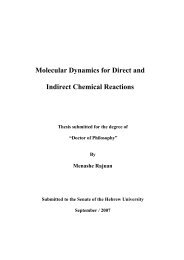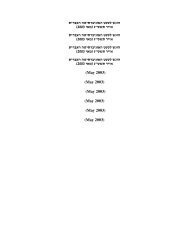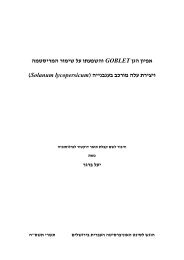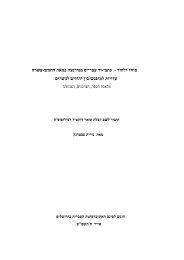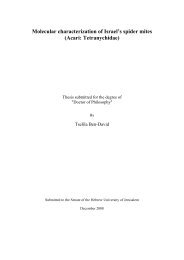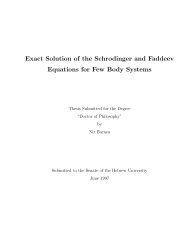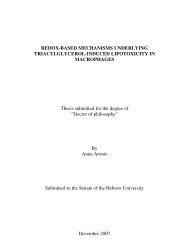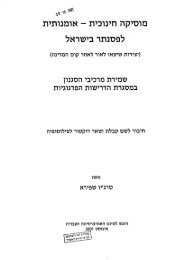Revealing the Mechanism of HSP104 Transcription Initiation in the ...
Revealing the Mechanism of HSP104 Transcription Initiation in the ...
Revealing the Mechanism of HSP104 Transcription Initiation in the ...
You also want an ePaper? Increase the reach of your titles
YUMPU automatically turns print PDFs into web optimized ePapers that Google loves.
perhaps not surpris<strong>in</strong>gly, overexpression <strong>of</strong> Msn2 could suppress <strong>the</strong> growth<br />
phenotype observed for Rpb4, but only at 34 o C. It would be <strong>in</strong>terest<strong>in</strong>g to test<br />
whe<strong>the</strong>r <strong>in</strong> rpb4∆ cells, Hsf1 b<strong>in</strong>ds <strong>the</strong> <strong>HSP104</strong> promoter and whe<strong>the</strong>r <strong>the</strong><br />
modifications <strong>of</strong> histones H3 and H4 still take place.<br />
The study presented <strong>in</strong> this <strong>the</strong>sis allows establishment <strong>of</strong> a model describ<strong>in</strong>g<br />
<strong>the</strong> molecular events lead<strong>in</strong>g to <strong>the</strong> transcriptional activation <strong>of</strong> <strong>the</strong> <strong>HSP104</strong> promoter:<br />
under optimal growth conditions, <strong>the</strong> promoter is occupied by Hsf1 and acetylated<br />
histones. Under <strong>the</strong>se conditions, <strong>the</strong> promoter is only partially active via <strong>the</strong> 34bp<br />
(most probably via <strong>the</strong> HSE at -304 to -300), but also partially via downstream STREs<br />
(because lower basal levels are measured <strong>in</strong> msn2∆msn4∆ cells or <strong>in</strong> constructs<br />
lack<strong>in</strong>g <strong>in</strong>ternal STREs, <strong>the</strong> ∆78 constructs). Upon lower<strong>in</strong>g cAMP levels,<br />
permanently, such as <strong>in</strong> ras∆2 cells or under stress conditions, cells remove <strong>the</strong><br />
negative regulation imposed by <strong>the</strong> Ras/cAMP/PKA pathway on Msn2/4. This<br />
enables <strong>the</strong> nuclear localization <strong>of</strong> <strong>the</strong> STRE-b<strong>in</strong>d<strong>in</strong>g transcriptional activators which<br />
subsequently leads to <strong>the</strong> transcriptional activation <strong>of</strong> STRE-conta<strong>in</strong><strong>in</strong>g genes. In<br />
parallel, upon heat shock (which also activates Msn2/4), HSE conta<strong>in</strong><strong>in</strong>g promoters<br />
are transcriptionally activated through <strong>the</strong> b<strong>in</strong>d<strong>in</strong>g <strong>of</strong> Hsf1. In <strong>the</strong> case <strong>of</strong> <strong>HSP104</strong>,<br />
<strong>the</strong> b<strong>in</strong>d<strong>in</strong>g <strong>of</strong> both transcriptional activators leads to proper transcriptional activation<br />
<strong>of</strong> this gene via <strong>the</strong> recruitment <strong>of</strong> chromat<strong>in</strong> modify<strong>in</strong>g complexes (<strong>in</strong> an Msn2/4<br />
dependent manner) which promote histone H4 deacetylation and disassembly <strong>of</strong><br />
acetylated H3 histones from nucleosomes. In addition to <strong>the</strong>se chromat<strong>in</strong><br />
modifications, proper transcriptional <strong>in</strong>duction could be enhanced through <strong>the</strong><br />
recruitment <strong>of</strong> <strong>the</strong> SRB/MED complex [perhaps via Hsf1 (39)]. F<strong>in</strong>ally, <strong>the</strong> RNA<br />
PolII is recruited, but it must be <strong>in</strong> its holoenzyme form (i.e., conta<strong>in</strong><strong>in</strong>g all subunits<br />
<strong>in</strong>clud<strong>in</strong>g Rpb4)<br />
Thus, we now have a comprehensive work<strong>in</strong>g model that describes <strong>the</strong> major<br />
molecular steps lead<strong>in</strong>g to <strong>the</strong> transcriptional activation <strong>of</strong> <strong>the</strong> <strong>HSP104</strong> gene.<br />
REFERENCES<br />
1. Aalfs, J. D., and R. E. K<strong>in</strong>gston. 2000. What does 'chromat<strong>in</strong> remodel<strong>in</strong>g'<br />
mean? Trends Biochem Sci 25:548-55.<br />
2. Agalioti, T., S. Lomvardas, B. Parekh, J. Yie, T. Maniatis, and D. Thanos.<br />
2000. Ordered recruitment <strong>of</strong> chromat<strong>in</strong> modify<strong>in</strong>g and general transcription<br />
factors to <strong>the</strong> IFN-beta promoter. Cell 103:667-78.<br />
52



